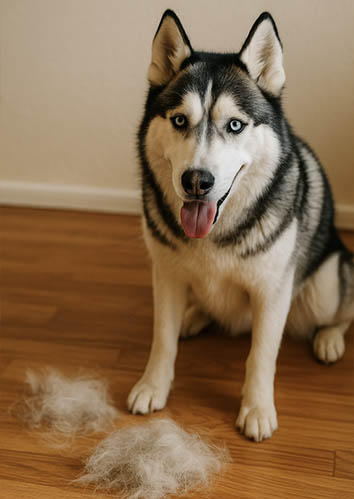
Fall and spring bring colorful leaves—but also clouds of pet hair around the house! Understanding seasonal shedding in dogs & cats helps you manage it before fur takes over your sofa.
🍁 What Is Seasonal Shedding?
All pets shed year-round, but during spring and fall, many (especially double-coated breeds) experience seasonal shedding—a natural process where they shed their old coat to prepare for temperature changes (splootvets.com, hillspet.com).
Spring gets rid of winter insulation; fall sheds lighter summer fur to make way for a warmer winter coat. This cycle typically spans six to seven weeks and is triggered by daylight and hormonal shifts (four-paws.org).
🧬 Who Sheds Most?
Seasonal shedding is most common in double-coated breeds like Siberian Huskies and Maine Coons (24petwatch.com). Single-coated breeds shed less noticeably, though all pets naturally lose hair. Indoor pets may shed less intensely due to regulated light and temperature (hillspet.com).
⚠️ When Shedding Is a Concern
Occasional shedding is normal, but watch out for these signs:
- Bald patches
- Excessive scratching
- Skin inflammation or dandruff
These symptoms may signal allergies, parasites, or hormonal issues (splootvets.com, thegentlevetdvm.com). If you see unusual shedding, schedule a vet check-up.
✂️ Tips to Manage Seasonal Shedding
1. 🪥 Grooming Routine
Brush regularly with breed-appropriate tools—daily during peak shedding—to remove loose fur and support coat health (thesprucepets.com).
2. 🛁 Selective Bathing
A mild, moisturizing shampoo during shedding seasons can loosen fur before brushing. Don’t overbathe to avoid dry skin (24petwatch.com).
3. 🥗 Nutrition Matters
A balanced diet rich in protein, omega fatty acids, vitamins A, E, and biotin supports healthy skin and coats (splootvets.com).
4. 🧹 Clean Home Tips
Vacuum frequently, use lint rollers, and wash pet bedding weekly to reduce fur buildup.
5. 🩺 Veterinary Care
Regular check-ups help spot problems like allergies, parasites, or systemic conditions early (splootvets.com).
🌟 Benefits of Embracing Seasonal Shedding
- Healthier coat: Helps your pet prepare for temperature changes
- Reduced allergens: Regular grooming cuts down dander
- Bonding time: Brushing boosts your emotional connection
🐶 What to Do if Shedding Seems Off
Unusual shedding deserves attention. For pets losing hair year-round or showing skin issues, consider vet visits, allergy testing, and lifestyle adjustments (thegentlevetdvm.com, thesprucepets.com).
🧾 Final Thoughts on Seasonal Shedding in Dogs & Cats
Seasonal shedding is a natural, healthy process. By staying consistent with grooming, diet, and vet care, you can manage the hair and support your pet’s wellbeing through every season.
Disclaimer: This guide is for informational purposes only. Always consult your veterinarian for personalized advice or to address specific concerns about your pet’s health or shedding.
References:
- Sploot Vets. “Cat & Dog Shedding: Why it Happens & How to Manage.” Feb 28, 2025. (splootvets.com)
- Hill’s Pet Nutrition. “Understanding Shedding Season for Cats and Dogs.” May 2, 2024. (hillspet.com)
- 24PetWatch. “Shedding season survival: Managing seasonal shedding in dogs and cats.” (24petwatch.com)
- FOUR PAWS International. “Understanding Moulting in Dogs and Cats.” May 13, 2025. (four-paws.org)
- The Gentle Vet. “Seasonal vs Abnormal Shedding: When to Worry.” Sept 8, 2023. (thegentlevetdvm.com)
- Vetster. “Is your cat’s seasonal shedding normal?” Jan 31, 2024. (vetster.com)


